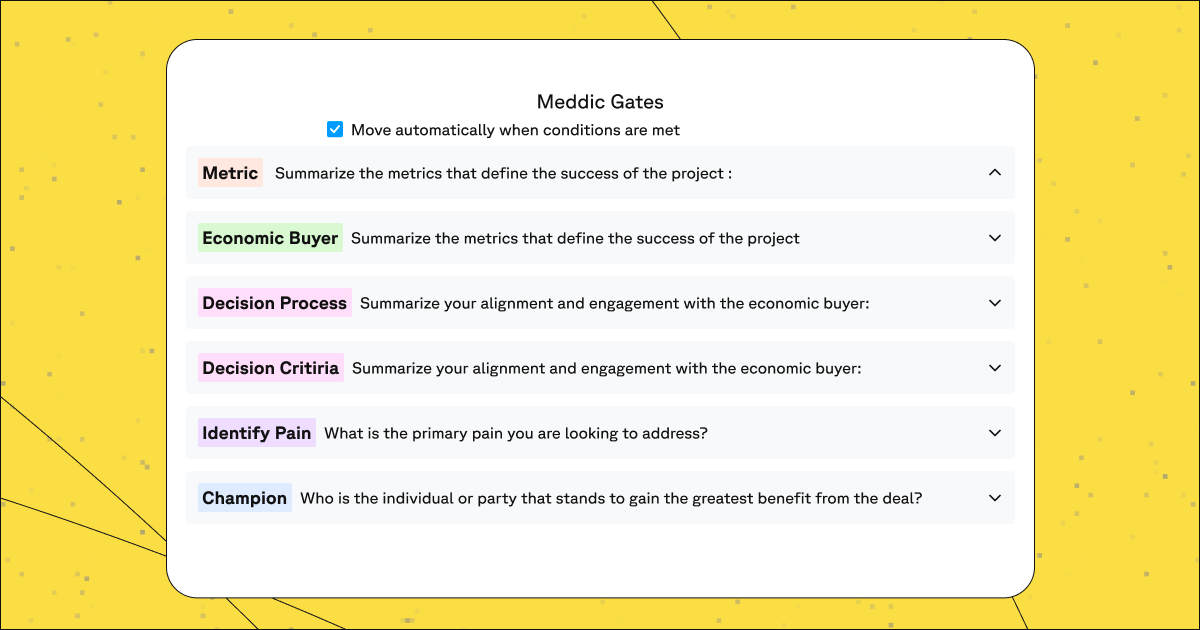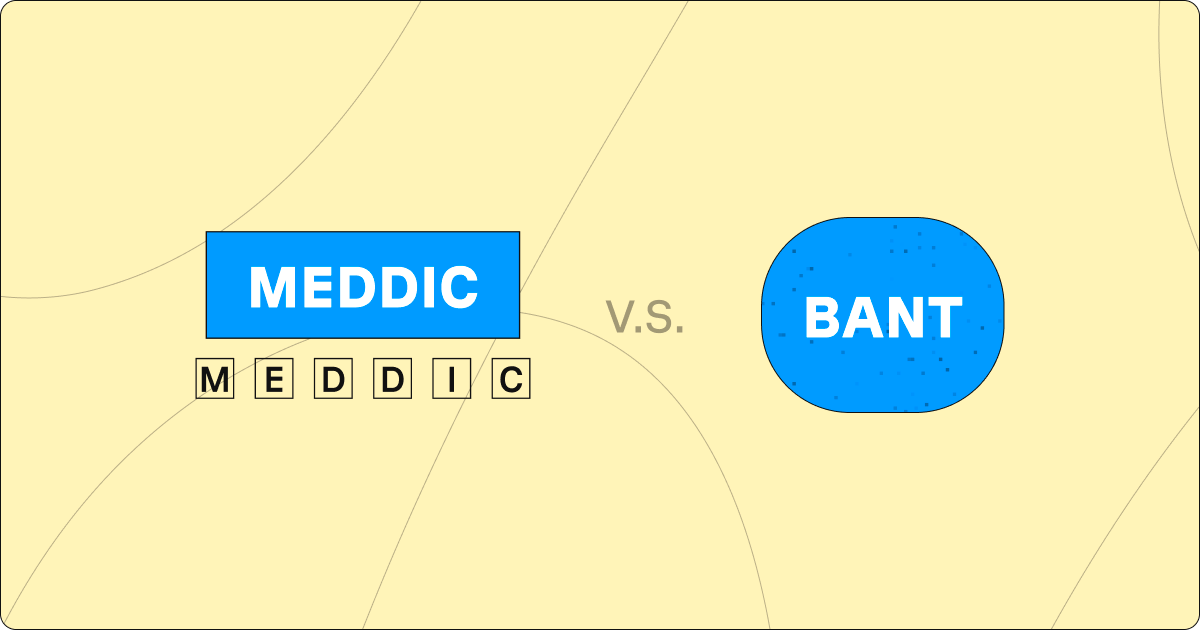
When it comes to running a successful sales operation, strategy matters. Many sales leaders rely on specific methodologies that provide the team with guidelines that help determine criteria to qualify leads as well as frameworks to support conversations with potential customers.
Two popular methodologies are MEDDIC and BANT. While both methodologies can be used to drive conversion, they do have different strengths, weaknesses and best use cases.
In this article, we’ll compare the two methodologies while also sharing how to integrate them into Salesforce to support your specific sales process and lead scoring.
Want to get started using Sweep's sales methodology templates right away? Sign up for free to explore all of your options.
Understanding MEDDIC and BANT
When you work on or with a sales team, you know how valuable lead qualification can be. After all, having the sales reps reach out to a ton of leads who are not interested in your product results in fewer conversions as well as a ton of wasted time. By using MEDDIC or BANT, sales teams can help in identifying prospects' readiness and capability to buy. Again, this is to ensure that the person they’re communicating with is actually in a position to become a customer.
MEDDIC stands for: Metrics, Economic Buyer, Decision Criteria, Decision Process, Identify Pain, Champion
BANT stands for: Budget, Authority, Need, Timeline
While both frameworks aim to qualify leads, they differ in focus and application. It’s important to understand these differences before moving forward with a singular approach.
MEDDIC explained
MEDDIC is often used in complex sales environments. It primarily helps teams focus on building deeper relationships with customers.
This approach emphasizes understanding prospects' decision-making processes. It helps sales reps engage with key stakeholders effectively. MEDDIC ensures alignment with the buyer's needs and pain points.
With MEDDIC, team members need to identify a "Champion" within the prospect's organization. They advocate for your solution and aid in navigating the decision process.

BANT explained
BANT, on the other hand, is a bit more straightforward. It prioritizes budget, authority, need, and timeline. If your sales team is dealing with a high volume of leads or pursuing transactional sales, this may be the more efficient methodology.
In fact, its strength may come from its simplicity. According to a 2023 Gartner Digital Markets survey, over 52% of salespeople find it reliable to qualify prospects, 41% value its flexibility, and 36% say it supports their efforts in planning a timeline for the sales process.
The BANT framework quickly filters out unqualified leads. It assesses if the prospect has the budget and authority to make decisions. It also evaluates if there is a real need and an appropriate timeline for buying.
This approach is simple, making it easy for new sales reps to adopt. However, its traditional structure might overlook potential opportunities by ruling out leads too early.
Lead scoring and the sales process
Lead scoring is pivotal for successful sales. It ranks prospects based on their potential value. This helps sales teams prioritize efforts effectively.
Integrating lead scoring into the sales process transforms productivity. It ensures that sales efforts align with the most promising opportunities. Let's explore its impact further.
The role of lead scoring in sales
Lead scoring identifies high-potential prospects. It assigns scores based on predefined criteria. These criteria can include engagement level and fit with your ideal customer profile.
By focusing on scored leads, sales teams use their time wisely. They concentrate on those most likely to convert. This boosts efficiency and increases success rates.
Optimizing the sales process
Optimizing the sales process involves refining every step. It ensures prospects move smoothly from leads to customers. Efficient sales processes are crucial for high performance.
With optimization, sales teams understand every prospect's journey. They can identify bottlenecks and adjust strategies accordingly. This leads to shorter sales cycles and improved outcomes.
MEDDIC vs BANT: A comparative analysis
Choosing between MEDDIC and BANT depends on your sales environment. Both methodologies serve distinct purposes and offer unique advantages. Understanding their differences is crucial for making an informed decision.
MEDDIC is detailed, focusing on understanding the buyer's journey. It builds relationships with economic buyers and identifies pain points. This makes it ideal for complex B2B sales.
On the other hand, BANT is straightforward and faster. It prioritizes budget, authority, need, and timeline. Such clarity is beneficial in high-volume or transactional sales settings.
Both methodologies have their strengths and potential drawbacks. The choice hinges on your sales cycle complexity, team experience, and deal size. Analyzing these factors will guide you toward the best fit for your organization.
Pros and cons of MEDDIC
MEDDIC excels in understanding buyer motivations. It helps build strong connections with decision-makers. This often results in higher-value deals and improved forecast accuracy.
However, MEDDIC can lead to lengthy sales cycles. The depth of analysis requires time and effort. Smaller or less complex sales might find MEDDIC overwhelming.
Despite these challenges, MEDDIC's thoroughness offers significant rewards. It is preferred for strategic engagement and long-term customer relationships. This makes it invaluable for companies with intricate products or services.
Pros and cons of BANT
BANT provides simplicity and speed in qualifying leads. Its criteria are easy to understand, making it accessible for new sales reps. This model minimizes time spent on non-promising leads.
Yet, BANT's simplicity can be a limitation. It might miss opportunities if prospects are disqualified too early. This rigidity can be a disadvantage in consultative selling.
Despite this, BANT's efficiency is impressive. For companies with high lead volumes, it offers a quick filtering mechanism. It helps sales teams focus on leads with immediate potential.
Integrating MEDDIC and BANT into Salesforce
Integrating MEDDIC and BANT methodologies into Salesforce can elevate the sales process. This requires careful customization to track and evaluate leads effectively.
Salesforce's flexibility allows for the creation of custom fields and reports. This ensures sales teams have access to necessary details. Successfully integrating these methodologies involves aligning Salesforce functionalities with specific sales strategies.
Customizing Salesforce for MEDDIC
To tailor Salesforce for MEDDIC, focus on capturing critical data points like decision criteria and economic buyer. Create custom fields to document metrics and identify champions within a prospect's organization.
Adding automated alerts can improve data accuracy and compliance with the MEDDIC process. Salesforce dashboards provide visual insights into prospects' buying processes, enabling effective strategy adjustments. This customization supports deeper engagement with potential clients and improves win rates.
Customizing Salesforce for BANT
For BANT customization, it's essential to track budget and authority with dedicated fields. Salesforce can automate reminders and prompts to ensure timelines are met and needs are addressed.
Building streamlined reports aids in quickly assessing leads. Salesforce's automation tools can expedite processes, allowing sales reps to filter leads efficiently and focus on high-potential opportunities. By doing so, teams can reduce sales cycle lengths and enhance productivity.
Customizing Salesforce for BANT or MEDDIC with Sweep
Sweep offers easy-to-use sales methodology templates designed to help your team integrate the right framework directly into Salesforce. If you decider to go with MEDDIC, Sweep’s template provides step-by-step instructions for ensuring the correct implementation within your environment. Similarly, if you want to use BANT, the template outlines exactly what is required of the team to ensure a seamless onboarding experience.
Choosing the right methodology for your team
Selecting the appropriate sales methodology can significantly impact your team's success. It's essential to understand your sales environment and customer base. Different methodologies suit different sales scenarios and cycles.
Consider the complexity of your sales processes and the products involved. MEDDIC often excels in complex, high-value B2B sales. Meanwhile, BANT might be preferable for straightforward, high-volume environments.
Factors to consider
When choosing between MEDDIC and BANT, there are several factors to evaluate. Look at the typical length of your sales cycle and the average deal size. Complex sales with longer cycles might benefit from MEDDIC’s strategic approach.
Assess the skills and experience of your sales team. Determine if they’re ready for deep engagement or if they need something simpler. Also, consider your customer base's buying behavior and decision-making processes.
- Length and complexity of sales cycles
- Experience and capability of the sales team
- Customer decision-making processes
- Company sales strategy and objectives
These factors should guide your decision and help tailor the approach to better fit your company's specific needs.
Transitioning between methodologies
Transitioning from one sales methodology to another can be challenging. It requires careful planning and communication. Involve your sales team early in the decision-making process to ensure buy-in and smooth adoption.
Training is critical during the transition phase. Equip your team with the necessary tools and knowledge to adapt to the new methodology. Constant feedback and performance monitoring will facilitate the transition, helping identify areas that need further support. This approach ensures that the switch enhances sales performance without disruption.
MEDDIC vs. BANT - Making the best choice
In the dynamic world of sales, choosing between MEDDIC and BANT hinges on your specific needs. Both methodologies offer distinct advantages and cater to different sales environments. By carefully evaluating your sales processes and team capabilities, you can select the most effective approach.
Ultimately, the right choice will align with your sales strategy and objectives. Consider the nature of your products and customers to determine which methodology fits best. Whether you opt for MEDDIC's strategic depth or BANT's simplicity, a thoughtful decision will drive improved sales outcomes.
If you want to see how Sweep can support your sales methodology implementation, book a demo with one of our team members.











